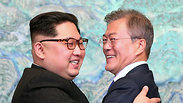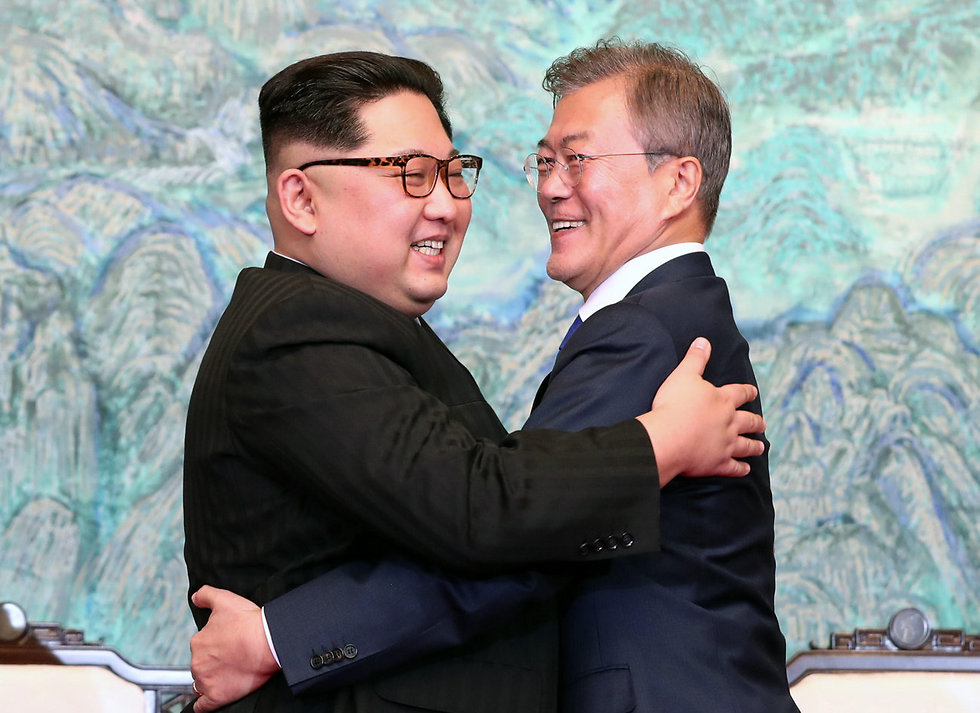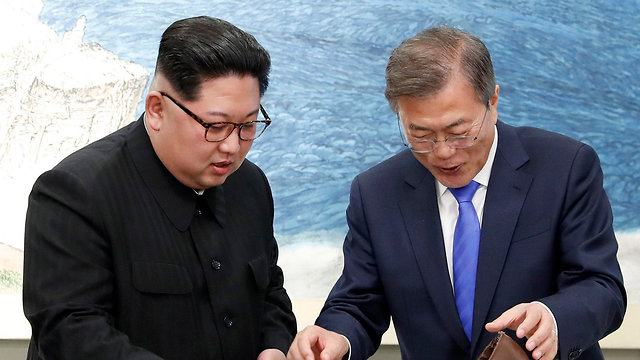
Kim and Moon's summit on Friday
Photo: AFP

S. Korea: North to close nuclear test site in May
Days after historic summit, Seoul's presidential office says N. Korea's leader Kim Jong Un willing to allow journalists, experts to nuclear test site for its shut down; 'Once we start talking, the US will know I am not a person to launch nuclear weapons at South Korea, the Pacific or the US,' Kim quoted as saying.
SEOUL - North Korean leader Kim Jong Un has vowed to shut down the country's nuclear test site in May and open the process to experts and journalists from South Korea and the United States, Seoul's presidential office said Sunday.
The event may serve as a dramatic setup to Kim's crucial nuclear negotiations with US President Donald Trump that may take place in the next few weeks amid widespread skepticism on whether the North will ever fully surrender its nuclear weapons.
Kim made the comments during his summit with South Korean President Moon Jae-in on Friday at a border truce village, where he also expressed optimism about his meeting with Trump, saying the US president will learn he's "not a person" to fire missiles toward the United States, Moon's spokesman Yoon Young-chan said.
"Once we start talking, the United States will know that I am not a person to launch nuclear weapons at South Korea, the Pacific or the United States," Yoon quoted Kim as saying.
"If we maintain frequent meetings and build trust with the United States and receive promises for an end to the war and a non-aggression treaty, then why would be need to live in difficulty by keeping our nuclear weapons?" Yoon quoted Kim as saying.
North Korea this month announced it has suspended all tests of nuclear devices and intercontinental ballistic missiles and plans to close its nuclear testing ground.
Kim reacted to skepticism that the North would only be closing down the northernmost test tunnel at the site in Punggye-ri, which some analysts say became too unstable to conduct further underground detonations following the country's sixth and most powerful nuclear test in September. In his conversation with Moon, Kim denied that he would be merely clearing out damaged goods, saying that the site also has two new tunnels that are larger than previous testing facilities, Yoon said.
The Friday summit between Moon and Kim kicked off a global diplomatic drive to deal with the North's nuclear and missile threats, which after a flurry of weapons tests last year involve purported thermonuclear weapons, developmental ICBMs and quick-fire solid-fuel missiles.
While the meeting ended with no new concrete measures on the nuclear standoff, the more substantial discussions on the North's denuclearization—including what, when and how it would occur—were always going to be reserved for a Kim-Trump summit.
צילום: רויטרס
The new round of nuclear negotiations with North Korea comes after a decades-long cycle of crises, stalemates and broken promises that allowed the country the room to build a legitimate arsenal.
Seoul has said Kim expressed genuine interest in dealing away his nuclear weapons. But North Korea for decades has been pushing a concept of "denuclearization" that bears no resemblance to the American definition, vowing to pursue nuclear development unless Washington removes its troops from the Korean Peninsula and the nuclear umbrella defending South Korea and Japan. There is widespread doubt whether Kim will ever agree to entirely abandon his nuclear weapons when he clearly sees them as providing his only guarantee of survival in a region surrounded by enemies.
Some analysts see Moon's agreement with Kim at Friday's summit as a disappointment, citing the lack of references to verification and time frames and also the absence of a definition on what would constitute as a "complete" denuclearization of the peninsula.
But Patrick McEachern, a former State Department analyst currently with the Washington-based Wilson Center, said it was still meaningful that Moon extracted a commitment from Kim to complete denuclearization, which marked a significant change from Kim's previous public demand to expand his nuclear arsenal quantitatively and qualitatively.
"The two leaders established a framework for plausible resolution of the most pressing issues on the peninsula, credibly agreed to further leader-level discussions, and frankly recognized the devil will be in the details of implementation," he said.
"This is a great start and should be cause for cautious optimism," McEachern said. "The public conversation should now shift from speculation on whether North Korea would consider denuclearization to how South Korea and the United States can advance this denuclearization pledge in concrete steps in light of North Korea's reciprocal demands for concrete steps toward an eventual peace agreement."
North Korea has invited the outside world to witness the dismantling of its nuclear facilities before. In June 2008, international journalists live broadcast the demolishing of a cooling tower at the Nyongbyon reactor site, a year after the North reached an agreement with the US and four other nations to disable its nuclear facilities in return for an aid package worth about $400 million.
But the six-nation deal eventually collapsed after North Korea refused to accept US-proposed verification methods and the country went on to conduct its second nuclear test detonation in May 2009.


















